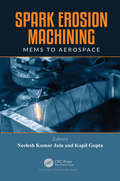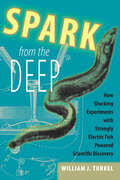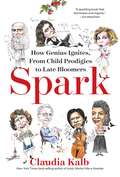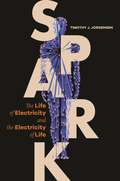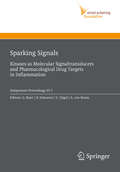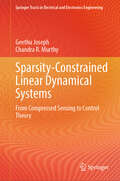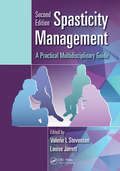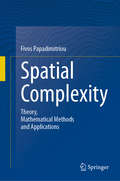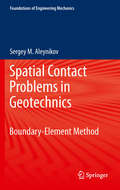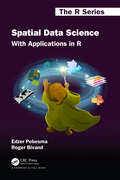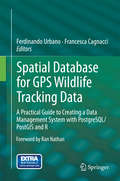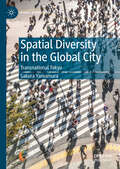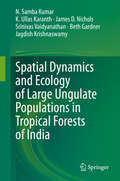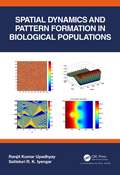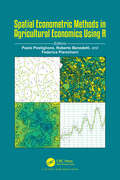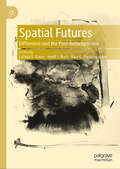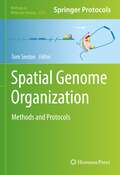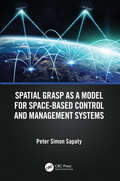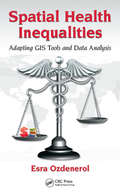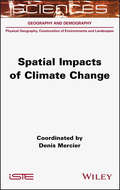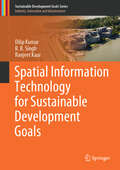- Table View
- List View
Spark Erosion Machining: MEMS to Aerospace
by Neelesh Kumar Jain; Kapil GuptaThis book bridges the gaps where limited resources are available on comprehensive coverage of spark erosion machining (SEM) based processes. It provides researchers and scholars a vast amount of information on recent research on the subject. It also serves as a resource of novel and specialized applications of spark erosion machining and its variants, for students and faculties involved with advanced machining processes. Some salient features of the book: Describes various important aspects of spark-erosion based processes including their derived and hybrid processes. Includes a broad scope of SEM applications from industrial, commercial, and scientific to aerospace, automobiles and biomedical domains. Covers a wide range of materials applications of SE-based processes to different exotic and difficult-to-machine materials, i.e. superalloys, composites, ceramics, shape memory alloys, etc. Provides details micro version of EDM and WEDM processes and their specialized applications.
Spark from the Deep: How Shocking Experiments with Strongly Electric Fish Powered Scientific Discovery (Animals History Culture)
by William J. TurkelHow encounters with strongly electric fish informed our grasp of electricity.Spark from the Deep tells the story of how human beings came to understand and use electricity by studying the evolved mechanisms of strongly electric fish. These animals can shock potential prey or would-be predators with high-powered electrical discharges.William J. Turkel asks completely fresh questions about the evolutionary, environmental, and historical aspects of people’s interest in electric fish. Stimulated by painful encounters with electric catfish, torpedos, and electric eels, people learned to harness the power of electric shock for medical therapies and eventually developed technologies to store, transmit, and control electricity. Now we look to these fish as an inspiration for engineering new sensors, computer interfaces, autonomous undersea robots, and energy-efficient batteries.Praise for Spark from the Deep“This beautifully written and exhaustively researched book traces the links between experiments on strongly electric fish and scientific understanding of electricity . . . Turkel’s book is a joy to read; it will entertain and educate scientists, historians, and anyone with an interest in the natural world.” —Choice“Turkel’s book convincingly reminds us that all the laptops and gadgets we surround ourselves with are remixes; altered versions of strongly electric fish. For that strange and insightful observation, this book ought to be widely read and enjoyed.” —Chris Conway, Endeavour“[I]t is refreshing to explore a book which takes seriously ancient encounters with manifestations of natural electricity as precursors to more recent innovations.” —James F. Stark, The British Journal for the History of Science
Spark from the Deep: How Shocking Experiments with Strongly Electric Fish Powered Scientific Discovery (Animals, History, Culture)
by William J. TurkelHow encounters with strongly electric fish informed our grasp of electricity.Spark from the Deep tells the story of how human beings came to understand and use electricity by studying the evolved mechanisms of strongly electric fish. These animals have the ability to shock potential prey or would-be predators with high-powered electrical discharges.William J. Turkel asks completely fresh questions about the evolutionary, environmental, and historical aspects of people’s interest in electric fish. Stimulated by painful encounters with electric catfish, torpedos, and electric eels, people learned to harness the power of electric shock for medical therapies and eventually developed technologies to store, transmit, and control electricity. Now we look to these fish as an inspiration for engineering new sensors, computer interfaces, autonomous undersea robots, and energy-efficient batteries.
Spark: How Genius Ignites, From Child Prodigies to Late Bloomers
by Claudia KalbYo-Yo Ma's ear for music emerged not long after he learned to walk. By the age of seven, he was performing for President Kennedy; by fifteen he debuted at Carnegie Hall. Maya Angelou, by contrast, didn't write her iconic memoir, I Know Why the Cage Bird Sings, until she was 40. What propels some individuals to reach extraordinary creative heights in the earliest years of life while others discover their passions decades later? Are prodigies imbued with innate talent? How often are midlife inspirations triggered by propitious events, like Julia Child's first French meal at the age of 36? Do late bloomers reveal their talents because their skills require life experience and contemplation? Through engaging storytelling and intriguing historical and cutting-edge scientific research, best-selling author and acclaimed journalist Claudia Kalb explores these questions to uncover what makes a prodigy and what drives a late bloomer. In this series of linked biographies, Kalb follows the journeys of thirteen remarkable individuals--from Shirley Temple to Alexander Fleming to Eleanor Roosevelt to Bill Gates--to discover the secrets behind their talents. Each possessed a unique arc of inspiration. Each--through science, art, music, theater, and politics--reached extraordinary success at different stages of life. And each offers us a chance to explore the genesis--and experience--of genius.
Spark: The Life of Electricity and the Electricity of Life
by Timothy J. JorgensenA fresh look at electricity and its powerful role in life on EarthWhen we think of electricity, we likely imagine the energy humming inside our home appliances or lighting up our electronic devices—or perhaps we envision the lightning-streaked clouds of a stormy sky. But electricity is more than an external source of power, heat, or illumination. Life at its essence is nothing if not electrical.The story of how we came to understand electricity’s essential role in all life is rooted in our observations of its influences on the body—influences governed by the body’s central nervous system. Spark explains the science of electricity from this fresh, biological perspective. Through vivid tales of scientists and individuals—from Benjamin Franklin to Elon Musk—Timothy Jorgensen shows how our views of electricity and the nervous system evolved in tandem, and how progress in one area enabled advancements in the other. He explains how these developments have allowed us to understand—and replicate—the ways electricity enables the body’s essential functions of sight, hearing, touch, and movement itself.Throughout, Jorgensen examines our fascination with electricity and how it can help or harm us. He explores a broad range of topics and events, including the Nobel Prize–winning discoveries of the electron and neuron, the history of experimentation involving electricity’s effects on the body, and recent breakthroughs in the use of electricity to treat disease.Filled with gripping adventures in scientific exploration, Spark offers an indispensable look at electricity, how it works, and how it animates our lives from within and without.
Sparking Signals
by Gottfried Baier Ulrich Zügel Burkhart Schraven Arne Von BoninThe importance of the protein kinase family is underscored by numerous disease states that arise due to dysregulation of kinase activity. Recent progress in understanding the molecular regulation of kinases has led to the development of new therapeutics based on the inhibition of kinase activity. In this book, well known experts present their most recent findings on the fast developing kinase field. It will be of interest to basic researchers and the pharmaceutical industry.
Sparsity-Constrained Linear Dynamical Systems: From Compressed Sensing to Control Theory (Springer Tracts in Electrical and Electronics Engineering)
by Geethu Joseph Chandra R. MurthyThis volume provides a comprehensive overview of recent research advances in the upcoming field of sparse control and state estimation of linear dynamical systems. The contents offer a detailed introduction to the subject by combining classical control theory and compressed sensing. It covers conceptual foundations, including the formulation, theory, and algorithms, and outlines numerous remaining research challenges. Specifically, the book provides a detailed discussion on observability, controllability, and stabilizability under sparsity constraints. It also presents efficient, systematic, and rigorous approaches to estimating the sparse initial states and designing sparse control inputs. It also gives background materials from real analysis and probability theory and includes applications in network control, wireless communication, and image processing. It serves as a compendious source for graduate students and researchers in signal processing and control systems to acquire a thorough understanding of the underlying unified themes. The academic and industrial professionals working on the design and optimization of sparsity-constrained systems also benefit from the exposure to the array of recent works on linear dynamical systems and related mathematical machinery.
Spasticity Management: A Practical Multidisciplinary Guide, Second Edition
by Louise Jarrett Valerie StevensonSpasticity is a common symptom that arises in a wide range of neurological conditions. Unfortunately, a poor understanding and inadequate management of spasticity often results in it having a greater impact on patients than necessary. Using a multidisciplinary approach, Spasticity Management: A Practical Multidisciplinary Guide provides the essenti
Spatial Analysis and Modeling in Geographical Transformation Process
by Rajesh Bahadur Thapa Yuji MurayamaCurrently, spatial analysis is becoming more important than ever because enormous volumes of spatial data are available from different sources, such as GPS, Remote Sensing, and others. This book deals with spatial analysis and modelling. It provides a comprehensive discussion of spatial analysis, methods, and approaches related to human settlements and associated environment. Key contributions with empirical case studies from Iran, Philippines, Vietnam, Thailand, Nepal, and Japan that apply spatial analysis including autocorrelation, fuzzy, voronoi, cellular automata, analytic hierarchy process, artificial neural network, spatial metrics, spatial statistics, regression, and remote sensing mapping techniques are compiled comprehensively. The core value of this book is a wide variety of results with state of the art discussion including empirical case studies. It provides a milestone reference to students, researchers, planners, and other practitioners dealing the spatial problems on urban and regional issues. We are pleased to announce that this book has been presented with the 2011 publishing award from the GIS Association of Japan. We would like to congratulate the authors!
Spatial Complexity: Theory, Mathematical Methods and Applications
by Fivos PapadimitriouThis book delivers stimulating input for a broad range of researchers, from geographers and ecologists to psychologists interested in spatial perception and physicists researching in complex systems. How can one decide whether one surface or spatial object is more complex than another? What does it require to measure the spatial complexity of small maps, and why does this matter for nature, science and technology? Drawing from algorithmics, geometry, topology, probability and informatics, and with examples from everyday life, the reader is invited to cross the borders into the bewildering realm of spatial complexity, as it emerges from the study of geographic maps, landscapes, surfaces, knots, 3D and 4D objects. The mathematical and cartographic experiments described in this book lead to hypotheses and enigmas with ramifications in aesthetics and epistemology.
Spatial Contact Problems in Geotechnics
by Sergey AleynikovThis book presents a systematic approach to numerical solution for a wide range of spatial contact problems of geotechnics. On the basis of the boundary element method new techniques and effective computing algorithms are considered. Special attention is given to the formulation and analysis of the spatial contact models for elastic bases. Besides the classical schemes of contact deformation, new contact models are discussed for spatially nonhomogeneous and nonlinearly elastic media properly describing soil properties.
Spatial Data Science: With Applications in R (Chapman & Hall/CRC The R Series)
by Roger Bivand Edzer PebesmaSpatial Data Science introduces fundamental aspects of spatial data that every data scientist should know before they start working with spatial data. These aspects include how geometries are represented, coordinate reference systems (projections, datums), the fact that the Earth is round and its consequences for analysis, and how attributes of geometries can relate to geometries. In the second part of the book, these concepts are illustrated with data science examples using the R language. In the third part, statistical modelling approaches are demonstrated using real world data examples. After reading this book, the reader will be well equipped to avoid a number of major spatial data analysis errors. The book gives a detailed explanation of the core spatial software packages for R: sf for simple feature access, and stars for raster and vector data cubes – array data with spatial and temporal dimensions. It also shows how geometrical operations change when going from a flat space to the surface of a sphere, which is what sf and stars use when coordinates are not projected (degrees longitude/latitude). Separate chapters detail a variety of plotting approaches for spatial maps using R, and different ways of handling very large vector or raster (imagery) datasets, locally, in databases, or in the cloud. The data used and all code examples are freely available online from https://r-spatial.org/book/. The solutions to the exercises can be found here: https://edzer.github.io/sdsr_exercises/.
Spatial Database for GPS Wildlife Tracking Data
by Ferdinando Urbano Francesca CagnacciThis book guides animal ecologists, biologists and wildlife and data managers through a step-by-step procedure to build their own advanced software platforms to manage and process wildlife tracking data. This unique, problem-solving-oriented guide focuses on how to extract the most from GPS animal tracking data, while preventing error propagation and optimizing analysis performance. Based on the open source PostgreSQL/PostGIS spatial database, the software platform will allow researchers and managers to integrate and harmonize GPS tracking data together with animal characteristics, environmental data sets, including remote sensing image time series, and other bio-logged data, such as acceleration data. Moreover, the book shows how the powerful R statistical environment can be integrated into the software platform, either connecting the database with R, or embedding the same tools in the database through the PostgreSQL extension Pl/R. The client/server architecture allows users to remotely connect a number of software applications that can be used as a database front end, including GIS software and WebGIS. Each chapter offers a real-world data management and processing problem that is discussed in its biological context; solutions are proposed and exemplified through ad hoc SQL code, progressively exploring the potential of spatial database functions applied to the respective wildlife tracking case. Finally, wildlife tracking management issues are discussed in the increasingly widespread framework of collaborative science and data sharing. GPS animal telemetry data from a real study, freely available online, are used to demonstrate the proposed examples. This book is also suitable for undergraduate and graduate students, if accompanied by the basics of databases
Spatial Diversity in the Global City: Transnational Tokyo (Global Diversities)
by Sakura YamamuraThis book, at the nexus of migration and urban studies, sheds new light on a long-neglected group of transmigrants and the global city of Tokyo. Using extensive empirical material on transnational migrants from above and below, it locates and better specifies spatial diversification in Tokyo and beyond. By incorporating transnational spaces into urban diversity discourses, it extends the superdiversity debate to a socio-spatial dimension and examines the configuration and processes of diversity and diversification in global cities from a socio-spatial perspective. Unique in its theoretical focus on the spatial aspect of superdiversity, the book delivers rare empirical insights into the daily socio-spatial practices of transnational financial professionals and other transmigrants. This social geographical study reveals the complex interplay between global mobility and urban transformation. It will be of particular interest to urban and migration scholars in fields such as urban sociology, social geography, and urban anthropology, offering deep engagement with debates on urban diversity and transnational spaces.
Spatial Dynamics and Ecology of Large Ungulate Populations in Tropical Forests of India
by K. Ullas Karanth N. Samba Kumar Jagdish Krishnaswamy James D. Nichols Srinivas Vaidyanathan Beth GardnerLarge ungulates in tropical forests are among the most threatened taxa of mammals. Excessive hunting, degradation of and encroachments on their natural habitats by humans have contributed to drastic reductions in wild ungulate populations in recent decades. As such, reliable assessments of ungulate-habitat relationships and the spatial dynamics of their populations are urgently needed to provide a scientific basis for conservation efforts. However, such rigorous assessments are methodologically complex and logistically difficult, and consequently many commonly used ungulate population survey methods do not address key problems. As a result of such deficiencies, key parameters related to population distribution, abundance, habitat ecology and management of tropical forest ungulates remain poorly understood. This book addresses this critical knowledge gap by examining how population abundance patterns in five threatened species of large ungulates vary across space in the tropical forests of the Nagarahole-Bandipur reserves in southwestern India. It also explains the development and application of an innovative methodology – spatially explicit line transect sampling – based on an advanced hierarchical modelling under the Bayesian inferential framework, which overcomes common methodological deficiencies in current ungulate surveys. The methods and results presented provide valuable reference material for researchers and professionals involved in studying and managing wild ungulate populations around the globe.
Spatial Dynamics and Pattern Formation in Biological Populations
by Ranjit Kumar Upadhyay Satteluri R. IyengarThe book provides an introduction to deterministic (and some stochastic) modeling of spatiotemporal phenomena in ecology, epidemiology, and neural systems. A survey of the classical models in the fields with up to date applications is given. The book begins with detailed description of how spatial dynamics/diffusive processes influence the dynamics of biological populations. These processes play a key role in understanding the outbreak and spread of pandemics which help us in designing the control strategies from the public health perspective. A brief discussion on the functional mechanism of the brain (single neuron models and network level) with classical models of neuronal dynamics in space and time is given. Relevant phenomena and existing modeling approaches in ecology, epidemiology and neuroscience are introduced, which provide examples of pattern formation in these models. The analysis of patterns enables us to study the dynamics of macroscopic and microscopic behaviour of underlying systems and travelling wave type patterns observed in dispersive systems. Moving on to virus dynamics, authors present a detailed analysis of different types models of infectious diseases including two models for influenza, five models for Ebola virus and seven models for Zika virus with diffusion and time delay. A Chapter is devoted for the study of Brain Dynamics (Neural systems in space and time). Significant advances made in modeling the reaction-diffusion systems are presented and spatiotemporal patterning in the systems is reviewed. Development of appropriate mathematical models and detailed analysis (such as linear stability, weakly nonlinear analysis, bifurcation analysis, control theory, numerical simulation) are presented. Key Features Covers the fundamental concepts and mathematical skills required to analyse reaction-diffusion models for biological populations. Concepts are introduced in such a way that readers with a basic knowledge of differential equations and numerical methods can understand the analysis. The results are also illustrated with figures. Focuses on mathematical modeling and numerical simulations using basic conceptual and classic models of population dynamics, Virus and Brain dynamics. Covers wide range of models using spatial and non-spatial approaches. Covers single, two and multispecies reaction-diffusion models from ecology and models from bio-chemistry. Models are analysed for stability of equilibrium points, Turing instability, Hopf bifurcation and pattern formations. Uses Mathematica for problem solving and MATLAB for pattern formations. Contains solved Examples and Problems in Exercises. The Book is suitable for advanced undergraduate, graduate and research students. For those who are working in the above areas, it provides information from most of the recent works. The text presents all the fundamental concepts and mathematical skills needed to build models and perform analyses.
Spatial Econometric Methods in Agricultural Economics Using R
by Paolo PostiglioneModern tools, such as GIS and remote sensing, are increasingly used in the monitoring of agricultural resources. The developments in GIS technology offer growing opportunities to agricultural economics analysts dealing with large and detailed spatial databases, allowing them to combine spatial information from different sources and to produce different models. The availability of these valuable sources of information makes the advanced models suggested in the spatial statistic and econometric literature applicable to agricultural economics. This book aims at supporting stakeholders to design spatial surveys for agricultural data and/or to analyse the geographically collected data. This book attempts to describe the main typology of agricultural data and the most appropriate methods for the analysis, together with a detailed description of the available data sources and their collection methods. Topics such as spatial interpolation, point patterns, spatial autocorrelation, survey data analysis, small area estimation, regional data modelling, and spatial econometrics techniques are covered jointly with issues arising from the integration of several data types. The theory of spatial methods is complemented by real and/or simulated examples implemented through the open-source software R.
Spatial Futures: Difference and the Post-Anthropocene
by Heidi J. Nast Alex G. Papadopoulos LaToya E. EavesSpatial Futures invites readers to imagine power and freedom through the lens of the ‘Black Outdoors’, a transdisciplinary spatial concept that operates beyond the planetary, stratigraphic confines of the ‘Anthropocene’. The chapters collectively point to the ontological-epistemological contradictions involved in forging liberatory spatial futures. Bringing new spatial imaginaries to bear in and outside geography, the book refuses the strictures of the ‘cenic’, entertaining difference as world-making.
Spatial Genome Organization: Methods and Protocols (Methods in Molecular Biology #2532)
by Tom SextonThis detailed volume explores a variety of cutting-edge techniques used to interrogate spatial genome organization. Beginning with a section covering the vital chromosome conformation capture (3C) technique, this collection continues with chapters on targeted Hi-C approaches, sequencing-based approaches to assess nuclear environment, as well as single-cell technologies to better characterize the heterogeneity and dynamics of nuclear architectures and approaches to visualize them by microscopy. Finally, in order to be able to ask functional questions about the role of spatial chromatin organization in genomic control, the last section provides methods for acute manipulations of chromatin architecture. Written for the highly successful Methods in Molecular Biology series, chapters include introductions to their respective topics, lists of the necessary materials and reagents, step-by-step, readily reproducible laboratory protocols, and tips on troubleshooting and avoiding known pitfalls. Authoritative and practical, Spatial Genome Organization: Methods and Protocols is an ideal resource for researchers searching for the best techniques to address their own specific research questions.
Spatial Grasp as a Model for Space-based Control and Management Systems
by Peter Simon SapatyGovernmental agencies and private companies of different countries are actively moving into space around Earth with the aim to provide smart communication and industry, security, and defense solutions. This often involves massive launches of small, cheap satellites in low earth orbits, which is also contributing to the growth of space debris. The book offers a high-level holistic system philosophy, model, and technology that can effectively organize distributed space-based systems, starting with their planning, creation, and growth. The Spatial Grasp Technology described in the book, based on parallel navigation and pattern-matching of distributed environments with high-level recursive mobile code, can effectively provide any networking protocols and important system applications, by integrating and tasking available terrestrial and celestial equipment. This book contains practical examples of technology-based solutions for tracing hypersonic gliders, continuing observation of certain objects and infrastructures on Earth from space, space-based command and control of large distributed systems, as well as collective removal of increasing amounts of space junk. Earlier versions of this technology were prototyped and used in different countries, with the current version capable of being quickly implemented in traditional industrial or even university environments. This book is oriented toward system scientists, application programmers, industry managers, and university students interested in advanced MSc and PhD projects related to space conquest and distributed system management. Dr Peter Simon Sapaty, Chief Research Scientist, Ukrainian Academy of Sciences, has worked with networked systems for five decades. Outside of Ukraine, he has worked in the former Czechoslovakia (now Czech Republic and Slovakia), Germany, the UK, Canada, and Japan as a group leader, Alexander von Humboldt researcher, and invited and visiting professor. He launched and chaired the Special Interest Group (SIG) on Mobile Cooperative Technologies in Distributed Interactive Simulation project in the United States, and invented a distributed control technology that resulted in a European patent and books with Wiley, Springer, and Emerald. He has published more than 250 papers on distributed systems and has been included in the Marquis Who’s Who in the World and Cambridge Outstanding Intellectuals of the 21st Century. Peter also works with several international scientific journals.
Spatial Health Inequalities: Adapting GIS Tools and Data Analysis
by Esra OzdenerolThe neighborhoods and the biophysical, political, and cultural environments all play a key role in affecting health outcomes of individuals. Unequal spatial distribution of resources such as clinics, hospitals, public transportation, fresh food markets, and schools could make some communities as a whole more vulnerable and less resilient to adverse health effects. This somber reality suggests that it is rather the question of "who you are depends upon where you are" and the fact that health inequality is both a people and a place concern. That is why health inequality needs to be investigated in a spatial setting to deepen our understanding of why and how some geographical areas experience poorer health than others. This book introduces how spatial context shapes health inequalities. Spatial Health Inequalities: Adapting GIS Tools and Data Analysis demonstrates the spatial health inequalities in six most important topics in environmental and public health, including food insecurity, birth health outcomes, infectious diseases, children’s lead poisoning, chronic diseases, and health care access. These are the topics that the author has done extensive research on and provides a detailed description of the topic from a global perspective. Each chapter identifies relevant data and data sources, discusses key literature on appropriate techniques, and then illustrates with real data with mapping and GIS techniques. This is a unique book for students, geographers, clinicians, health and research professionals and community members interested in applying GIS and spatial analysis to the study of health inequalities.
Spatial Impacts of Climate Change
by Denis MercierClimate change has been a central concern over recent years, with visible and highly publicized consequences such as melting Arctic ice and mountain glaciers, rising sea levels, and the submersion of low-lying coastal areas during mid-latitude and tropical cyclones. This book presents a review of the spatial impacts of contemporary climate change, with a focus on a systematic, multi-scalar approach. Beyond the facts – rises in temperature, changes in the spatial distribution of precipitation, melting of the marine and terrestrial cryosphere, changes in hydrological regimes at high and medium latitudes, etc. – it also analyzes the geopolitical consequences in the Arctic and Central Asia, changes to Mediterranean culture and to viticulture on a global scale, as well as impacts on the distribution of life, for example, in the Amazon rainforest, in large biomes on a global scale, and for birds.
Spatial Inequalities
by Allan G. Hill Justin Stoler John R. WeeksThis book provides a fresh analysis of the demography, health and well-being of a major African city. It brings a range of disciplinary approaches to bear on the pressing topics of urban poverty, urban health inequalities and urban growth. The approach is primarily spatial and includes the integration of environmental information from satellites and other geospatial sources with social science and health survey data. The authors Ghanaians and outsiders, have worked to understand the urban dynamics in this burgeoning West African metropolis, with an emphasis on urban disparities in health and living standards. Few cities in the global South have been examined from so many different perspectives. Our analysis employs a wide range of GIScience methods, including analysis of remotely sensed imagery and spatial statistical analysis, applied to a wide range of data, including census, survey and health clinic data, all of which are supplemented by field work, including systematic social observation, focus groups, and key informant interviews. This book aims to explain and highlight the mix of methods, and the important findings that have been emerging from this research, with the goal of providing guidance and inspiration for others doing similar work in cities of other developing nations.
Spatial Information Technology for Sustainable Development Goals (Sustainable Development Goals Series)
by Dilip Kumar R.B. Singh Ranjeet KaurThis textbook aims to develop a scientific knowledge base on spatial information technology to communicate the United Nations' Sustainable Development Goals (SDGs) among students, researchers, professionals and laymen. The book improves understanding of the spatial database and explains how to extract information from this for planning purposes. To enhance the knowledge of geoscientists and environmentalists, the book describes the basic fundamental concepts to advance techniques for spatial data management and analysis and discusses the methodology. The Geographic Information System (GIS), remote sensing and Global Positioning System (GPS) are presented in an integrated manner for the planning of resources and infrastructure. The management of these systems is discussed in a very lucid way to develop the reader's skills. The proper procedure for map making and spatial analysis are included along with case studies to the reader. Where the first part of the book discusses the conceptual background, the second part deals with case studies using these applications in different disciplines. The presented case studies include land use, agriculture, flood, watershed characterization and infrastructure assessment for the Sustainable Development Goals.
